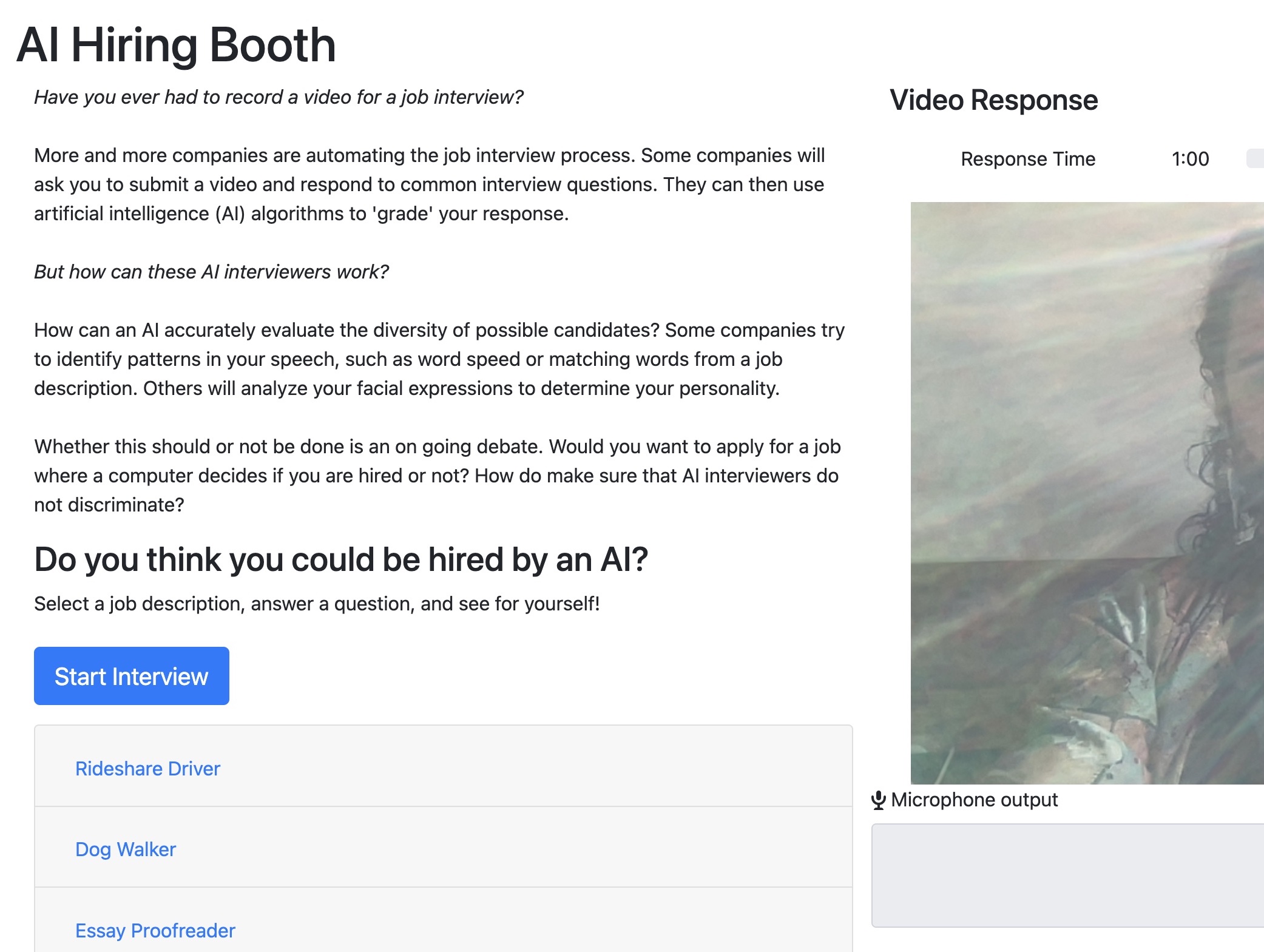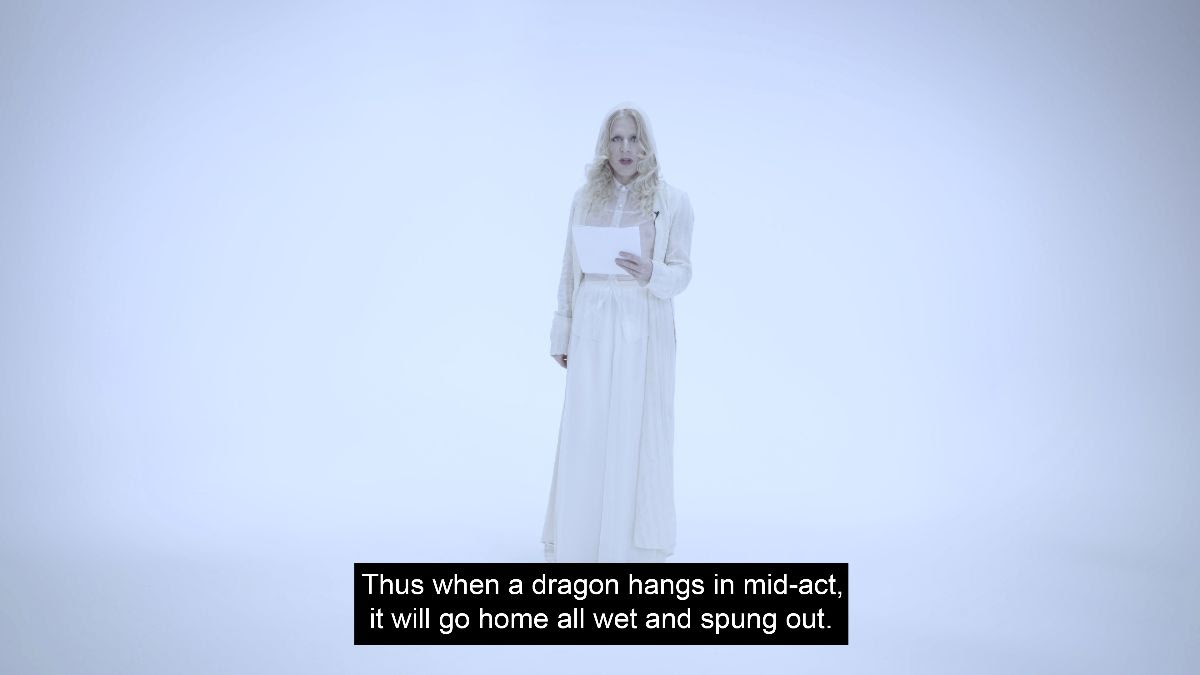Creative Portfolio
My goal is to use computation and AI as both a reflection
on our societal values and a mirror for the way we build technology.
If you are interested in collaborating, reach out. I am always looking to discuss new ideas and make associations.
Algorithmic Agonisms: Antagonizing AI Hiring Interviews
Do you think you could be hired by an AI?
As artificial intelligence is incorporated into more and more aspects of society, often
the public is left without notice,
even when an AI is used for a important life decision such as access to a job opportunites.
Through an interactive AI Hiring Booth, I invite participants to experience what
it may feel like to be hired or rejected by an AI algorithm.
As you go through the experience, I ask in what ways this can go wrong
and what forms of resistance we may need to hold employers accountable
to algorithmic discrimination and other harms.
and Dan and (when some small metal is spun)
“and Dan and (when some small metal is spun)” is a video based project in colaboration with Itziar Barrio, which involves the creation of a narrative using artificial-intelligence. This piece uses now legacy technology, GPT-2, a form of generative large-language Transformer model that was a predecessor to ChatGPT, to remind us of the importance and nuance of meaning. The language of poetry prevails in the final text resisting logic and opening future horizons. This exhibition explores the idea of meaning—or the lack there of—between the interplay of the AI model, the script, and performer Candystore's interpretation.
Presented at La MaMa Galleria in NYC as part of Itziar Barrio's 2023 solo exhibit.Roles for Computing in Social Change
Algorithmic injustices are pervasive: hiring systems prioritizing applications based on gender, algorithmic risk assessments discriminating on race, automation resulting in greater economic inequality. The potential harms of technology betray the need for a more socially-just, equitable-minded, and responsible-first practice of building technology.
This work is my attempt to reclaim the role technology has in larger societal progress. Inspired by “Roles for Computing in Social Change” by Abebe et al. (2020), I weave algorithms with generative art as a means to reflect on how we build technology and what it says about society. I aspire for more conversations, less solutions, and new insights. A sharable version of this portfolio is accessible here.

Computational Justice
COMPUTING AS REBUTTAL
Companies are quick to institute ‘diversity’ initiatives without evaluating whether they bring about structural change to their culture.
Computational Justice is a generative art piece which explores the ways institutions fail to address systemic sexism in the workplace.
This work produces visuals based on code derived from “Computational Justice: Simulating Structural Bias and Interventions.” Simulating how sexism spreads through social learning in small meetings, Momennejad et al. (2019) show how initiatives, such as affirmative action, fall short. Remediating the toll on gendered minorities requires changes in how people confront sexist comments. Translating simulated remarks to lines between perpetrators and victims, I trace how systemic sexism consumes a workplace’s culture.
This work is an ongoing exploration from my membership in the 2020 NEW INC program. By visualizing these technical simulations for the public, this work promotes deeper conversations around how to sustainably reduce sexism in the workplace.

Mutual Wayfinding I
COMPUTING AS DIAGNOSTIC
How does the Internet influence our psyches?
How does it move beyond the screen into our physical world?
Mutual Wayfinding is a process for examining how the digital blurs into our internal-psychological and external-physical worlds. Abstract paintings are fed into a neural network to generate a story, which is then interpreted into a photograph that becomes the seed for a new passage. This feedback loop exaggerates subtle shifts to explore how information from the Internet is produced and consumed.
This work is in collaboration with artists Terrill Warrenburg and Amanda Suarez who provided the abstract paintings and photographic interpretations, respectively.

Mutual Wayfinding II
COMPUTING AS SYNECDOCHE
Mutual Wayfinding II is a generative text piece that interrogates how different online communities discuss pressing issues such as climate change.
Individual neural networks are trained on a curation of either news, forum comments, or scientific papers that discuss climate change. The generated text acts as a mirror for the aggregate voices present in each dataset. By juxtaposing the disparate discourses around a topic, Mutual Wayfinding II explores how digital worlds can diverge on controversial issues.

Ring of Keys Cabaret
COMPUTING AS FORMALIZER
When the Quintessence of Dust theater company put on a cabaret with songs written from source material on individuals’ struggles with mental health, no one who was interviewed showed up to the performance. Each one cited that they did not want to risk seeing their trauma displayed on stage.
Ring of Keys Cabaret is a collaboration with NYC play-write Rachel Kunstadt that aims to break the stigma of mental health in the LGBTQ+ community. An AI is trained on interviews with LGBTQ+ individuals, and through the ‘strength in numbers’, generalizes across responses so that no one story is ever on display. Turning classical views of privacy-breaching algorithms up-side down, we explore how technology can protect stories rather than exploit them.
This work was developed at the New York Live Arts ACT Labs Live Ideas 2019 and received first-place runner up in the HACK-ART-THON.

